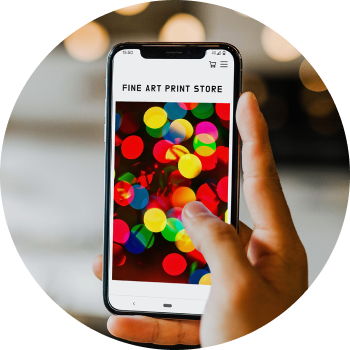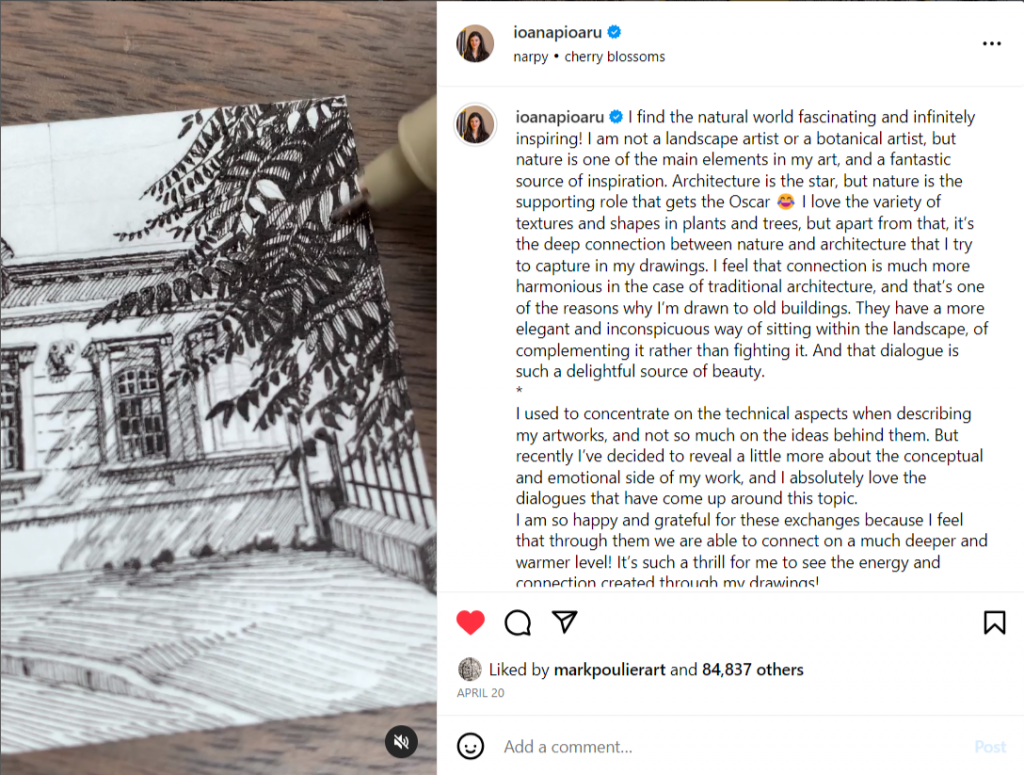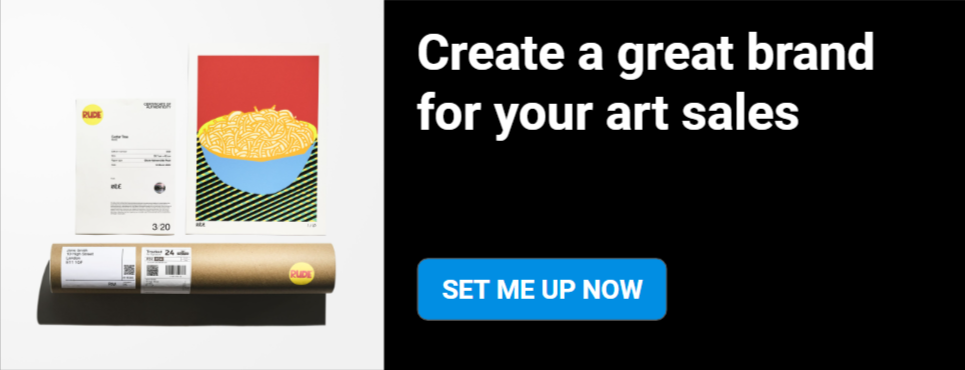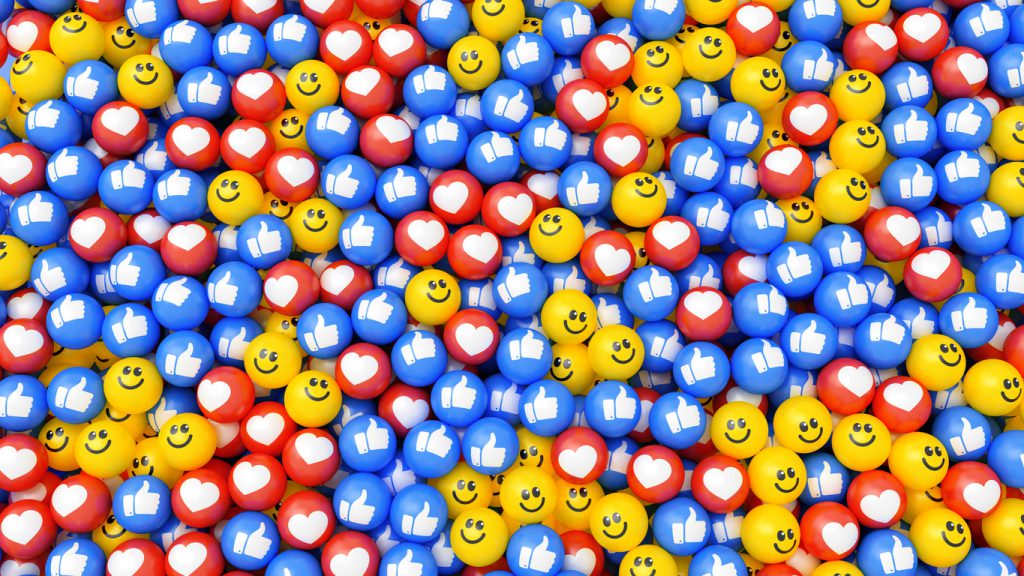
Have you ever heard anyone say Instagram is over for artists? That it isn’t possible to grow a following organically? I suspect you have, but when anyone says this it simply tells you one thing; that they have not moved with the times and understood how engagement and growth strategies on Instagram have changed. If you can learn this yourself then that’s your opportunity to grow.
This article is focussed on how artists and photographers can grow following.
So why do you want to grow your following in the first place? Instagram is an essential tool for artists to sell art online. Together with Twitter, these are the two main platforms right now for driving revenue when doing print drops, which is the best method for an artist to sell art online. It is possible that Threads could become a third platform for artists to sell, but at the time of writing it is too early to say.
So what’s the reward for a good following? A good monetisation rate for your following is $1 of online art sales per follower per annum. A great monetisation rate is $3 per follower per annum. To go from good to great you will need to use paid social ads to grow a specific print buying following. However you can get to $1 by growing your following, ensuring they are engaged with your content and by running timed print drops. We have many articles on our help centre and many discussions in our Facebook group about how to run timed print drops. This article is focussed on growing your following using Reels.
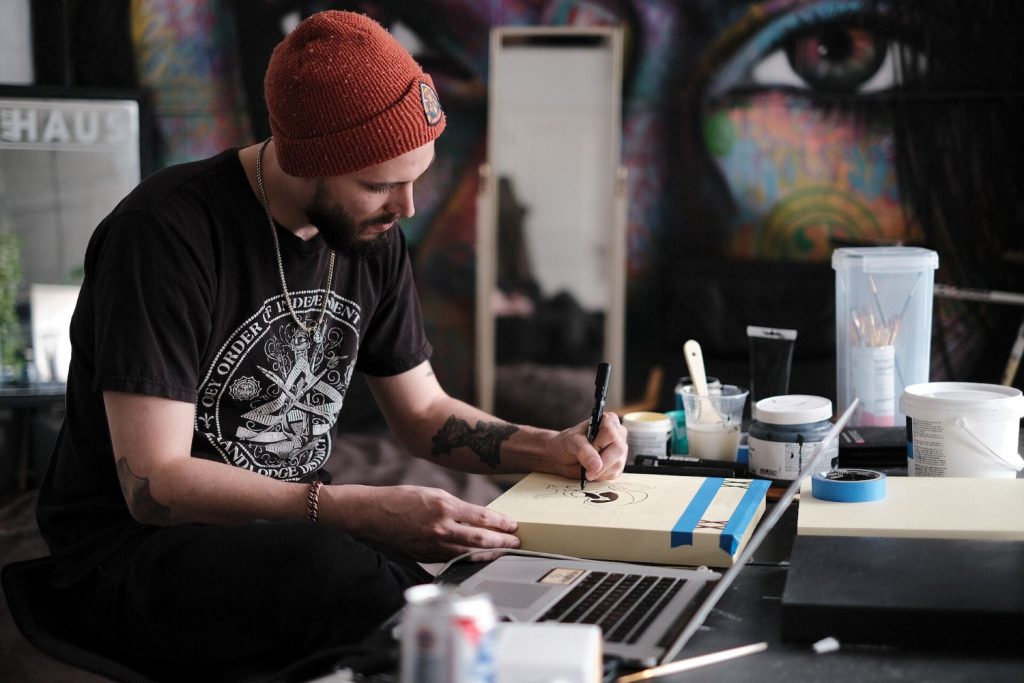
Social Media has changed art buying
Instagram has changed over the years, some say as a result of TikTok, but in fact both IG and TikTok have responded to improvements in tech which allows video to be recorded, edited with special effects, and posted all from smartphones using mobile data networks. Content consumers prefer video, or at least we can certainly say they spend longer watching it compared to looking at still images. We can speculate as to why, but surely one of the reasons is our propensity to want to consume information in a narrative format, which is a hard-wired human psychological trait.
Over the last 12 months IG has also prioritised carousel posts as well, which are a series of images or short videos that can be shown in any order and re-shown to people who have seen them before, but with a different first frame.
Both these formats enable you, the artist, to communicate a narrative to the consumer of your content. So, if you want people to remember some aspect of you or your art, you need to communicate via a narrative. The other skill you need is to be able to create hooks in your content, which is the thing that grabs the attention when you first see the post, the thing that stops people scrolling and gets them engaged.
Before we go deeper into examples of hooks and narratives in Reels and Carousels, I think it’s important to make a point as to the way social media has changed things. Social media is not just a type of communication, it’s a format. In much the same way the modern pop song created a standard format through which musicians communicate, social media has created a visual format.
The format does not just refer simply to the aspect ratio or the optimal length of narrative (i.e. 9:16 and between 10 and 45 seconds for Reels). It refers to the features and styles of the stories, editing, sentiments being expressed etc. Just like pop music, these things happen in trends with creators feeding off each other for inspiration and the consumers enjoying the familiarity of the ‘current sound’. Again just like pop music, there is room for people who go against the grain and do things entirely their own way, but the majority tend to learn the rules of the format before they break them.
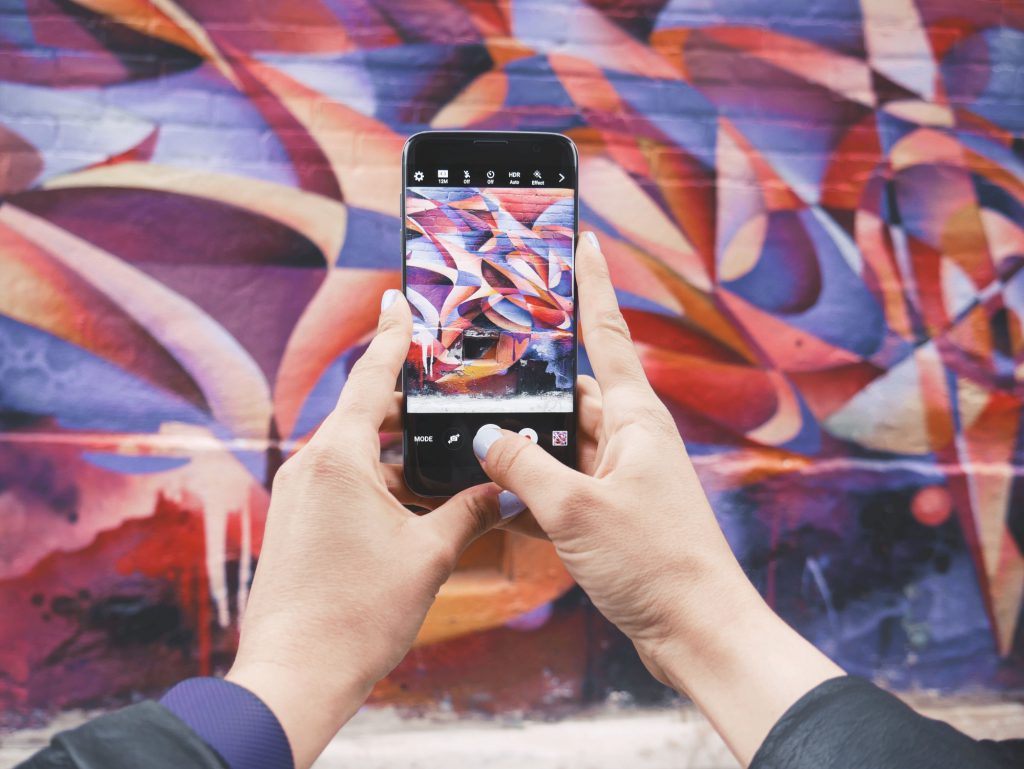
The ingredients of a Reel
Let’s focus down on Reels for a bit. One really interesting thing about Reels is the way the algorithm decides to show them to other Instagram users; they are the post type that is most likely to be shown to people who are not your followers. A really good Reel will be shown to up to 5x your follower numbers, a great Reel to 10x or more than the number of followers you have. As a result, perfecting Reels leads to fast follower growth.
So what’s the secret?
Firstly the Reel needs a hook. As we said earlier Reels, as with any posts, need a hook and a narrative. Because of the limitless content available on Instagram people tend to give only 3 seconds to a Reel to engage them before scrolling onwards. If people get beyond the 3 seconds then the algorithm takes this as a signal that people are likely to stop scrolling and start watching. A high ratio of people watching beyond 3 seconds means it has passed the first algorithmic test. It is said to have an effective hook. The second metric is regarding narrative, if the Reel has an effective narrative people will be more likely to watch until the end and share it, comment and hit like.
If both an effective hook and narrative are evident from the data of the first group of people the Reel is shown to, then Instagram will start to show it to expanding groups of people, based on having shared interests with the group who originally watched, liked, shared and commented on it in above average proportions. Instagram will keep expanding the groups the Reel is shown to until the responses from users return to at or below average levels.

To make the point, let’s return to the pop song format as an example. In the same way that the modern pop song needs to have a hook to capture people’s attention, so these formats need mainly visual hooks to do the same (although using trending catchy music on Reels really helps too).
To use the musical analogy, let’s take Smells Like Teen Spirit, ranked as one of the most successful tracks of all time and one that arguably helped to propel Nirvana to global stardom. It has great riffs that act as the hooks, and it has brilliant lyrics that set a tone of frustration, teenage angst, and a rejection of apathy, and of course it was sung by a charismatic angst-ridden lead singer Kurt Cobain. So it has a strong narrative/ message plus hooks and it wouldn’t have been as successful as it was if it was missing either. For anything you want to say to be listened to, you need both of these things too.
The most common mistake that I see when people are making reels is that they don’t think they need to put a hook into them. They think that their narrative is enough, and that should interest people. As humans we have a familiarity problem. No one is closer or more caught up in our own narrative than we are, and so we have a tendency to see the world a bit as centred around us. The trick is to consciously remove yourself from that way of thinking and to realise that no one else cares as much about what you want to say as you do, so you need to grab their attention. You do this with hooks. A brilliant narrative without a hook will get barely any views, a hook without a narrative will get views, but it won’t have the effect in building awareness of your art.
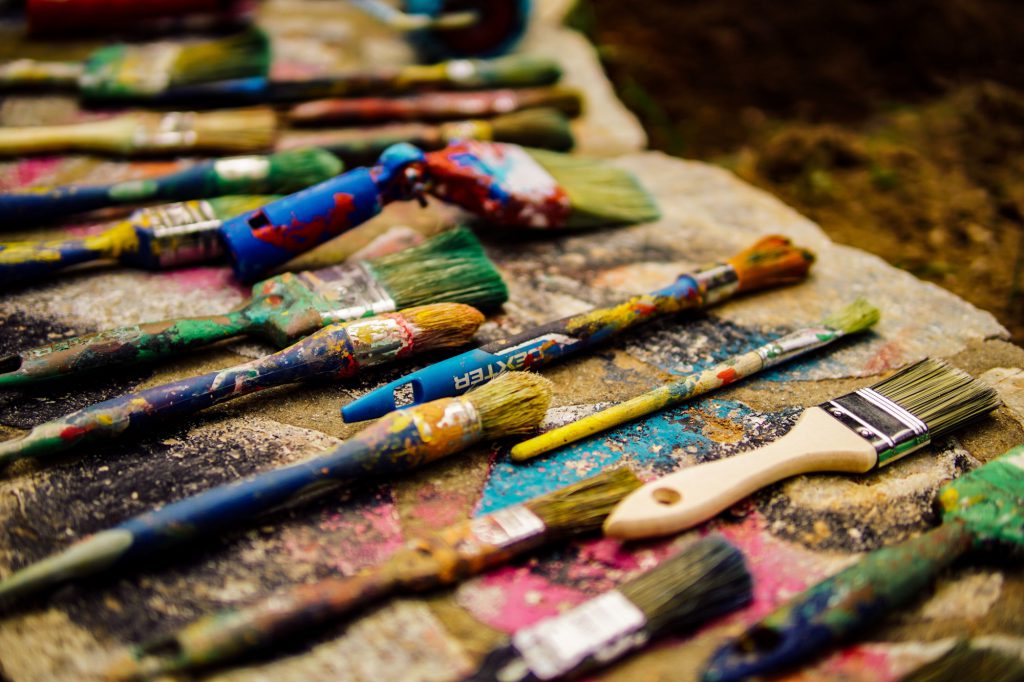
The benefits of carousels
Firstly, let’s look at a quantitative study that compares Reels with carousels. Here are the findings:
- Instagram Reels have had a 57.4% YoY growth in usage
- Reels generate the highest amount of saves for the smallest profiles
- Carousels spark the highest number of comments across all profile size
- With a double reach rate than the other post types, virality is more likely to be achieved through Reels
- Reels have a 2x higher average impression rate compared to the other Instagram content types
Source: Social Insider, June 27th 2023
In terms of growing your user numbers Reels are therefore better, as summarised by this graph:
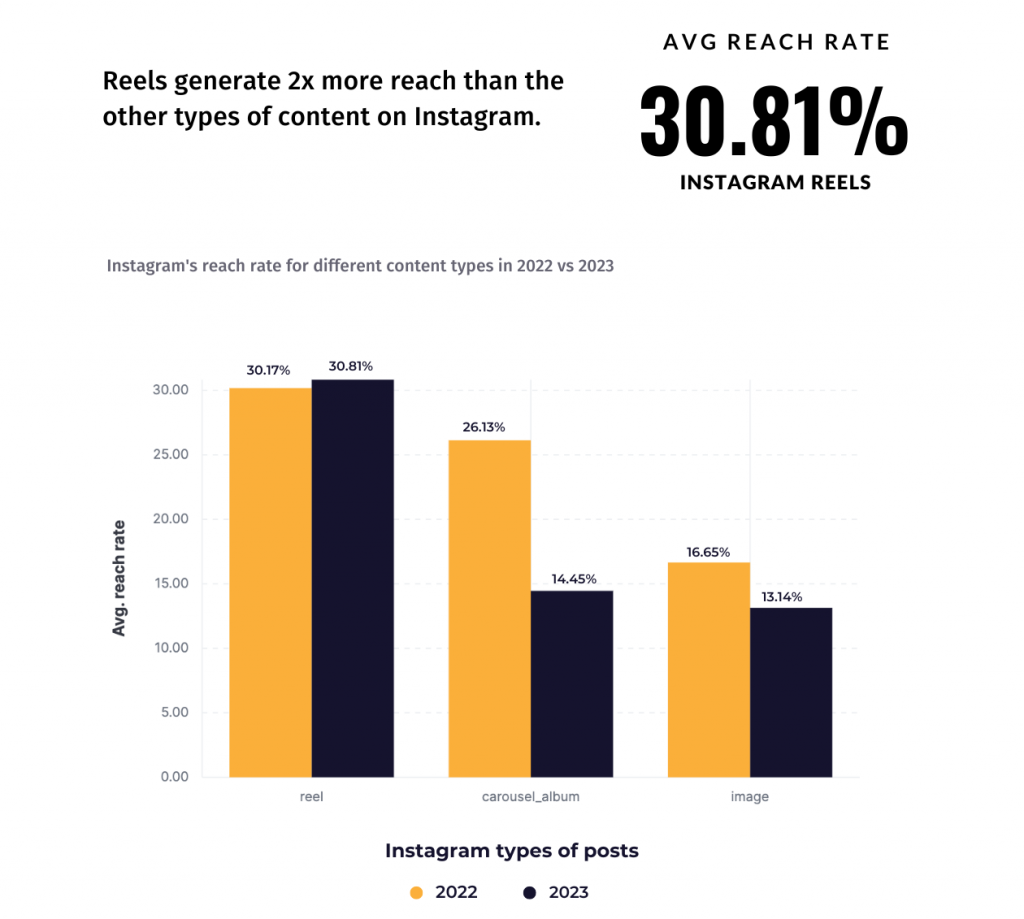
So carousels have good reach, but now it looks like they are not that much different to single images. However before we start to think that we may as well post single images, let’s think back to the concept of formats. Whereas Reels are the best format for growing followers, Carousel posts lend themselves to telling a narrative and so I think they are great posts for launching a print drop. You can show some of the work in progress, or if your print drop is more than one work you can show them both (we don’t recommend dropping more than 2 works at a time). You could include a very short video of an unboxing or you putting the print on the wall in your Carousel as it is a mixed stills & video format.
I am going to stray a little off from purely data-driven conclusions here and say that anecdotally I notice that the accounts I really engage with more deeply, carousels get shown to me numerous times to ensure that I have seen all of the slides (Instagram mixes up the order to show me the slides I haven’t viewed first). So it seems that this could be a good way to ensure your followers don’t miss your print drop.

How do you measure Reel or Carousel success?
Making great content for artists requires experimentation and iteration, plus imitating other people’s ideas that you see being successful. To make improvements and to judge success you need to know the key metrics. Here they are the main ones.
- Reels. The metric we look at is total plays vs follower numbers
- This is the core metric because it indicates whether the Reel has been seen by people who don’t follow you. Both these metrics can be seen on other people’s profiles, so it’s really useful for learning because you can measure the success of Reels not made by you, so you know which Reel styles you should consider learning.
- If total plays for a Reel are more than your follower numbers then the Reel was successful and will be helping you grow your following quickly. You should note down what you think made this Reel successful and make variations of it.
- If total plays are above 50% of your follower numbers, but not greater than them, then the Reel is OK and will be helping you reach and engage existing followers, and it may help you reach and engage some new ones too.
- Carousels. We look at two metrics; likes vs follower numbers, and reach.
- Likes vs follower numbers. This is great for looking at other people’s carousels and working out if the style is worth imitating. If the number of likes > 5% of the follower numbers then it is a good one. If the number of likes is >10% of the follower numbers it is a great one and most certainly worth looking at from the perspective of learning and imitating. It should be noted that for accounts with hundreds of thousands of followers it is harder to reach these percentages of likes vs followers, so your benchmark for what makes a good post should be much lower.
- Reach: This If reach > 15% then the post was successful. If it is up to 25% then the post was great and you should do more. This number is only visible to you for your posts, on your analytics.
- Thumbstop ratio (sometimes referred to as Hook rate). The thumbstop ratio measures the effectiveness of your hooks on Reels. Remember that most people only give a Reel around 3 seconds before scrolling onwards? So if your Reel is watched for more than 3 seconds then it must have a hook. The thumbstop ratio (or hook ratio) is calculated as the amount of >3 second plays as a percentage of total impressions of your Reel. A thumbstop ratio above 30% is good, above 50% is great.
- Traffic numbers & profile click-through-rate. There are two things you need to happen off Instagram; (1) adding email subscribers when you don’t have a print drop happening, and (2) selling art during a print drop. To do both you need to have clear, readable, enticing and authoritative CTAs (Calls to Action) which encourage the person viewing the content to click through to your profile, and then click your link-in-bio. The success of your CTAs are measured in the traffic numbers on your site (as measured by Google Analytics) or by the profile click-through-rate (CTR). The CTR is calculated by dividing the number of clicks to your website or email by the total number of profile views your Instagram account received in a time period. 4.7% is the Instagram average CTR, so you can benchmark this to measure how good your CTAs are. Of course, something we have not mentioned here is that IG Stories are one of the best methods for getting engaged Instagram followers onto your site as they allow links directly within them that can be clicked with an easy swipe up, so during drops and to build your email list you should be prolific with your stories. The flip side to this is IG Stories have less reach than posts.
Let’s summarise these benchmarks:
| Post Type | Objective | Metric | Good benchmark | Great benchmark |
| Reel | Follower Growth | Plays vs Followers | Plays > 50% of followers | Plays > followers |
| Reel | Art Sales/ Email List Growth | Profile CTR | >5% | >7% |
| Carousel | Follower Growth | Likes vs Followers | Likes >5% of followers | Likes >10% of followers |
| Carousel | Art Sales/ Email List Growth | Profile CTR | >5% | >10% |
| Stories | Art Sales/ Email List Growth | Reach % | >3% | >7% |
| Ads (Reels, Carousels or Stories) | All of the above | Thumbstop ratio (Hook rate) | >30% | >50% |
Now you know how to use data to work out if the content you make is successful. The next sections will explain how to do this.
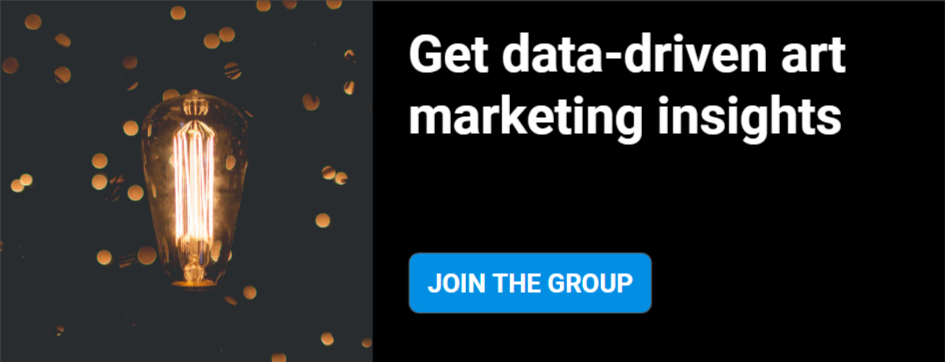
What makes a good Hook?
Hooks are things that spark sudden interest, emotion or are in some way catchy or familiar. The key thing is they must start to happen immediately when the Reel starts playing.
Here is a list of Hooks that artists regularly use, and it’s worth noting than none of these are mutually exclusive, your post can contain more than one:
Surprise
If you surprise people immediately at the start of the Reel then you are doing well in terms of grabbing attention. This could include the following:
- Start with a blank canvas, click your fingers or touch the canvas, and the art magically appears. Here’s some examples:
- Switching the visual context, so you think you are looking at one thing, turns out you’re looking at something different. Here’s an example:
- Use some surprising things about your artwork, the subject matter or the creative process: ‘I use a litre of paint per painting!’ ‘This image is a composite of 100 photos!’ ‘Each drawing takes 1 month!’ ‘Jupiter is 1,300 times bigger than the Earth!’ Here is an example:
Pose a question upfront
Instead of saying ‘I painted a cat’…say ‘Why do I paint cats?’
Instead of saying ‘I am fascinated with Space and that’s why I paint planets’ say ‘Why is Mars so fascinating?’
Instead of saying ‘This abstract painting shows the feeling of spring’ say ‘Why does this painting make me feel like springtime?’
Instead of saying ‘This is the inspiration for this painting’ ask ‘What inspired me to paint this dog/ lighthouse/ building etc?’
Here’s an example:
This is not a specific art example, but it is an excellent example of how to lead with a question to hook people in:
You could even do what this artist has done and ask people to help you name a piece:
There is even a new trend of Reel that starts with the question ‘Why do you paint?’ I’m sure if you watched Reels on Instagram, you’ll find examples of this.
Curiosity/ suspense
Here are some examples:
- Artists can use curiosity as a hook when they show their creative process. There will be a natural curiosity to see the finished work. However when doing this you should consider using stop motion or sped up footage to avoid losing people due to them realising they will have to wait too long to see the end result. Here’s some Reels of creative processes that create curiosity:
Sometimes slow can work. Here’s a reel that is much slower, but that suits the mood of the music and the work.
- Show people part of the process of making but not any sense of the final piece. You can use this to drive action to sign up to an email, attend an exhibition or go look at a print on your store. Here’s an example:
- Start zoomed right into a print and slowly zoom out so the viewer starts to realise what it might be after a few seconds but initially it is hard to see what it is.
- Show a timelapse or sections of footage of travelling to a photo shoot location and say ‘What am I shooting today?’
- Walk down the corridor to your studio, open the door and show what you’re making today. The walk down the corridor builds suspense.
- Show a tricky part of the creative process that may not work as you want it to. Articulate the challenge at the start by saying something like ‘This only works out half the time’
- If you have an interesting creative process, show it. Here’s an example:
- There is a trend to hold the canvas or print showing the back and then turn it round to show the finished piece. Here are some examples:
Amazing effects or editing
This could be using hyper-real visual styles or cutting your Reel in time to the music. For this it will help to develop your editing techniques. You need a bunch of techniques in your arsenal. The good news is that there are plenty of video apps and IG accounts that have tips on developing techniques and trends. One example is to time your cuts to the music. Like these examples:
Timing the cuts to the music is a great start, but there are so many wild and interesting editing techniques you can do beyond this. To learn them, follow this account.
You can even use a still image and Photoshop to create the sense of time passing or movement in a Reel, like this example:
Matching a Trend
There are certain trends you see with editing or styles of video where everyone does their own version of it. This piques curiosity, as you want to see that person’s take on it. For example recently there was an Instagram trend to do posts in the style of a Wes Anderson movie. Here’s an example:
Another recent trend has been to use stop motion combined with a mashup audio track of Radiohead and Kendrick Lamar. Here’s some examples of that:
Trending audio
Consider using trending audio. Music gets stuck in people’s heads and they will be more likely to watch the whole Reel if they like the track, it’s catchy and they are familiar with it. The more leftfield you go with your music choice the less the music will be able to drive Reel watchability on its own. However it’s also important the vibe of the music watches the vibe of the Reel so don’t compromise the overall feel of the Reel just to make it catchy. Here’s an example of using non-trending audio because it fits the vibe of the art.
The wow moment
A wow moment is a genuine moment where what you are looking at is unusually skilful or beautiful. This could be the detailed brush or pen strokes that demonstrate a highly unusual level of skill or an unusual creative process. It could be a video from the natural world, or something that shows some kind of daring or unusual. Or it could be a hugely impressive large scale work. Or it could just be something bright, colourful or beautiful from a pure aesthetic point of view. Here are some examples:
Other hook ideas
- Make an ASMR video. These are mesmerising, soothing or calming videos, like a visual stress ball. Repeated fine brush strokes or peeling away tape from an artwork to reveal it are two very soothing things to watch that create the ASMR vibe.
- Making a provocative or challenging statement. This is a little risky so maybe show people before you post…but when done right it can really work. Here is an example:
- Strangeness/ surrealness. Some leftfield music and surreal images that create a vibe from the get-go. Here’s some examples:
- Uplifting content. People watch and share positive things. Here is an example:
- Empathising with universal challenges is a good way to create hooks. For example, you can show the struggle as an artist, creative person or human being. You could ask the question up front such as ‘Do you doubt your own ability to do X?’ Or ‘Do you sometimes feel X?’ (btw you don’t necessarily need to include the question, you just need to tackle it). Here’s an example:
- Humour. This does work but be careful with it, it needs to be the hook, not the subject of your Reel. Your art should be the subject. Here are some examples:
If the humour dominates your feed you may grow followers, but maybe not ones who are interested in your art.
- Cuteness. Babies, dogs, cats, if they come into the video it’s never a bad thing. Cuteness engages:
Remember the hook and the narrative are two different concepts. The hook is the thing that grabs people but the narrative is what you want to say.
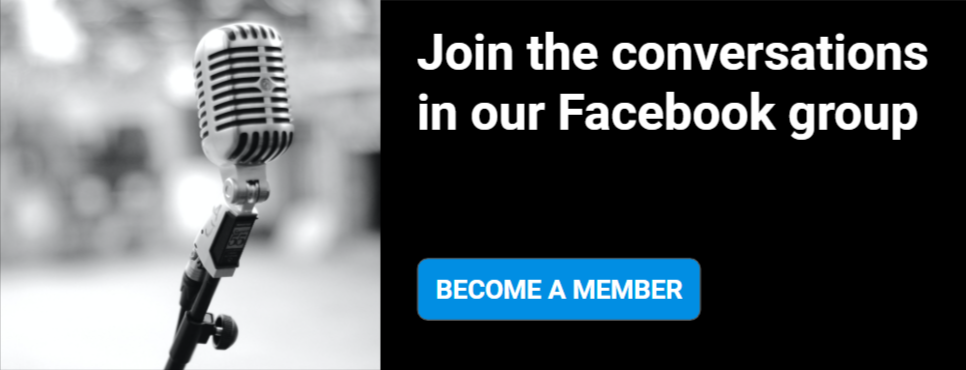
What makes a good narrative?
The narrative is the story of the video and the message contained within that story. So, as an example, the story could be a condensed Reel of the journey you took as a photographer to get to the physical location you took the shot. The message is how much you put into your creativity and art, how much of a passion it is. The hook is the beautiful sunrise at the start of that journey, a wow hook, and also the suspense of what you are going to shoot, which you can ensure lands by having a subtitle of ‘this shot has been planned for months…’
Again, similarly for a Reel where you show a timelapse of the painting being made, the hook is the incredibly skilled way of applying the paint to the canvas, the skilled brushstrokes. This is a wow hook. Also there is a curiosity hook in there of the viewer wondering what the final work will look like. The narrative contains the story of making the work, the challenges, the tricky parts, the outline, the structure, the details all leading to showing the final art piece. The message is how much patience, skill and dedication it takes to create this work, and how beautiful the end result is.
When we look at narratives we find it useful to divide them into narratives during a print drop which are specific to the work being dropped, and narratives outside of a print drop which are more general about your work & inspiration.
Print drop narratives
These again divide into 4 parts:
What did I make?
- You should have one post that just clearly shows the final piece that you have for sale as the image, which you could combine with other images in a Carousel showing it on a wall, with you holding the print, a short unboxing video or images or videos of you showing the print details. Here’s an example:
- There are creative ways to show what you made, for example zooming into the image to show the details or zooming out to reveal it.
- You can build up the finished artwork in layers cut to music. Watch an example here:
- You can do an unboxing video and post it as a reel, which is a classic piece of content but it definitely captures the excitement of the reveal, through you.
- You can hold the canvas or print showing the back and then turn it round slowly to show the finished piece…but you could try a more interesting variations of that too like this one:
- Or you can poke fun at the trend, like this one.
- Or you can do a fun, fast reveal like this.
How did I make it?
- This is a timelapse/ sped up Reel of the whole creation process or just an interesting part of it:
- Photographers can also show their process of production too. Here are some examples:
Subject matter context
Another way to talk about your work during the print drop is to talk about the subject matter. This is where you talk about what you drew/ photographed/ painted etc. It could be a person, animal, place, object, activity, scene etc. This means answering one or two of the following questions (as applicable):
- What do you find fascinating about it?
- How did you research it?
- How did you find it/ find out about it?
- How did you get there? (in the case of a place)
- How did you arrange it? (in the case of a person)
- Who are the people?
- What’s the story of the place/ people/ activity/ object?
Examples of this are:
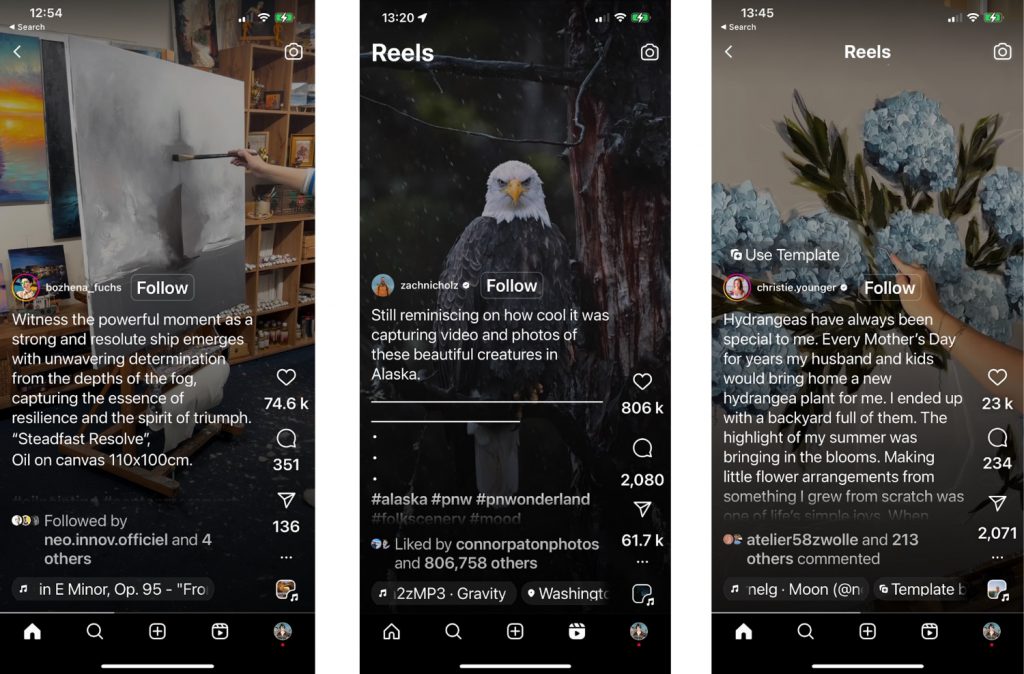
Why did I make it?
It is important to note that many artists on Instagram don’t cover this type of content and therefore it may not be absolutely necessary to sell, however buyers are interested in the motivations of artists. If you do cover this topic, don’t write an essay, just give a small amount of context around your motivations for making the piece, or how you felt when you were making it. You can use the caption or the main video subtitles or just communicate visually. To make this kind of content maybe try imagining you are responding to a question such as:
- Where were you when you made it?
- What was happening in your life?
- What artists, writers, musicians were influencing you?
- What things were on your mind when you made it?
- How did you feel when you were making it?
- What is the meaning of the work to you?
- What meanings or feelings were you trying to communicate with it?
Examples:
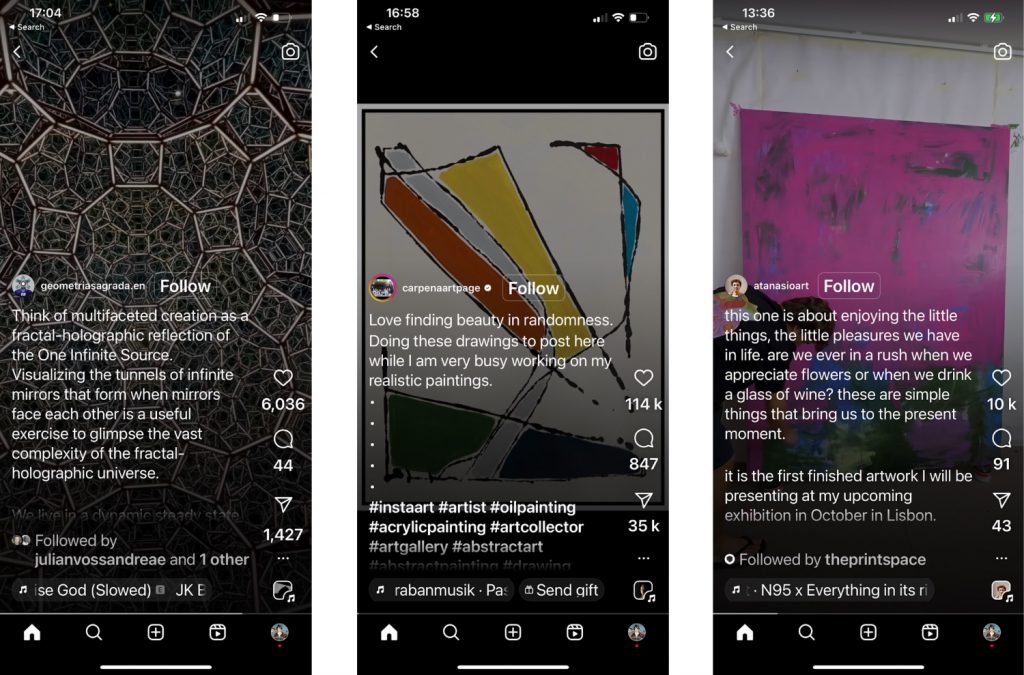
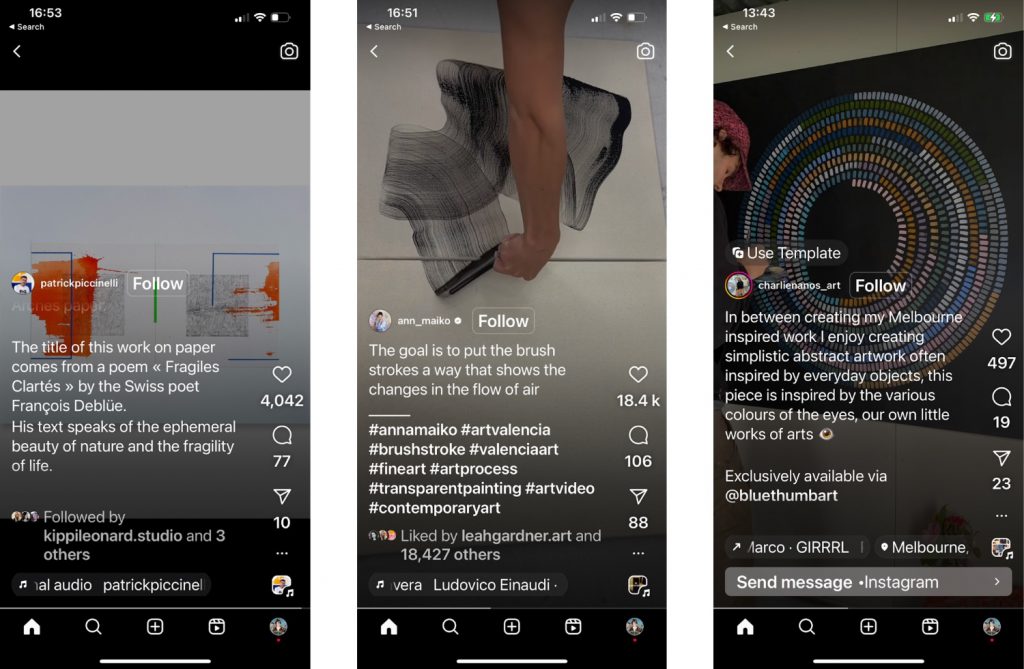
Outside of print drops
You can do any of the above, but you can also do some more general posts, as follows:
- What inspires you, how do you learn & develop. You can show sketches, work in progress, collected inspirations, techniques:
- Add some more detail about you as a person, the artist. People are always very interested in the artist themselves as their story adds context to the artwork. You could do things like:
- Show some personality, humour, opinions, challenges and feelings of being an artist
2. Make some autobiographical posts about you or your journey as an artist. Here’s some examples:
3. Make posts about your philosophy or outlook on life or creativity
4. Show a retrospective tour through some past work, which again shows your journey and development as an artist.
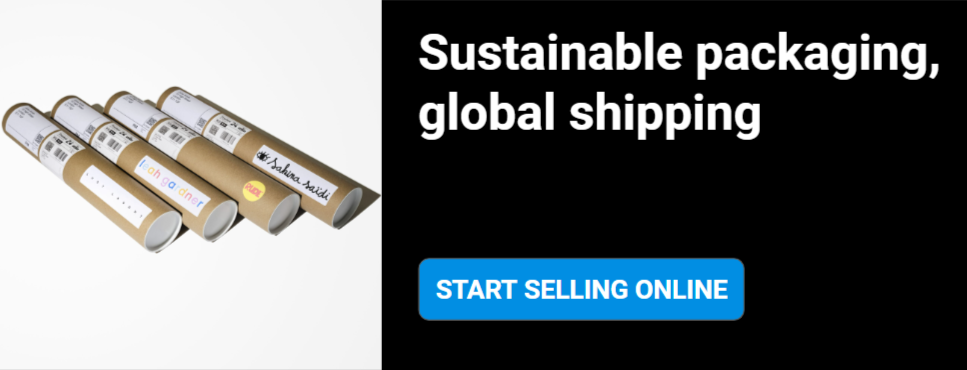
Additional Reel Techniques
Here’s some more really important considerations for your Reels.
- Text/ voiceover. The text subtitles on the video itself should be minimal. You want people watching your Reels, not reading. If your narrative is not told visually, then you are not working within the visual format and your Reel will be unlikely to be successful. Some sparingly used text can guide the narrative a little, in the same way an actor narrating a section of a film can. Voiceover adds the personalisation, the human touch, but in any case subtitles are necessary because 69% of people watch videos with the sound off when they are in public places, according to a study by Publicis Media. The same study also shows that 80% of people are more likely to finish a video if it has subtitles.
Here’s an example of a Reel that I think is a fascinating interesting story about making a painting, but it didn’t go viral and it didn’t achieve the benchmark (yet) of having more play than followers, and I think this is because the text is just way too much. If this was me I would have cut the subtitles text by at least 70%, and let the visuals tell the story. I would have moved the rest of the text to the expandable caption.
- Captions. Captions are the bit of text on a post that needs to be expanded to read, and they are a great way to add deeper comment on your work. This is where you can, if you want, expand further into the meaning and context. It is the perfect place to do it because it avoids making the video too text which can destroy engagement. In fact a study by Later showed that having long captions increases engagement, and this result was also confirmed by Hootsuite in a test they ran.
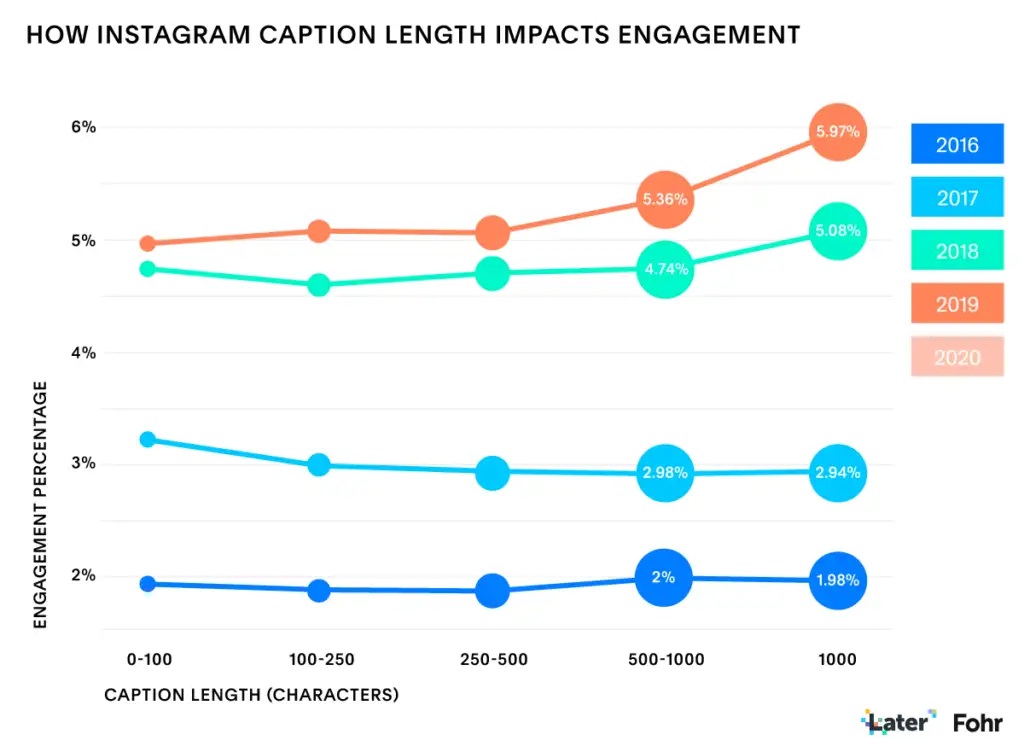
- Interactivity/ inviting comments. Reels perform better and reach more people if they get lots of comments. So in your caption or in the Reel ask a question, ask for some feedback.
- Repeat and rework. Don’t be afraid to repeat and rework your best ideas in new ways. Take a look at the examples below. It is basically the same idea repeated. The second time around it got 4x more views than the first one and all the versions will have helped follower growth.
1st one: https://www.instagram.com/reel/CmcEdx4hIdH/ (1.1M views)
2nd one: https://www.instagram.com/reel/CnulzqdhoZO/ (4.7M views)
3rd one: https://www.instagram.com/reel/CsHLVYXAJ-1/ (1.7M views)
- Smile. If you are in the video then make sure you smile, or if that is not in your personality or feels unnatural then at least don’t scowl! If you’re doing video with voiceover then practising presenting to the camera will make it feel natural. You have to fight your way through the awkward stage first, but it’s worth it.
- Brevity. Shorten it, then shorten it again. Every time you come back to re-edit a Reel you will find a way of saying the same thing with more brevity. Make shortening your Reels a default habit. Also speed up the footage where you can and where it doesn’t detract. Showing long or slow processes at a real time speed is not conducive to getting plays on IG.
- Templates. Try Instagram templates. This is a new development, but a very welcome one. IG knows what performs best and these templates help you to create a good edit very quickly. Here’s a little info on them. And here’s some of the results of using these templates:
- Carousels. Carousels are great for photographers to put together vibey photostories where the images work as a part of a set.
- Call To Action (CTAs). Always use CTAs on every post. If you have a print drop going on then the CTA is about the print drop, otherwise it is to join your email list. Separate your CTAs from the main body of the caption text with a line space and mark it with emojis:
??? PRINT DROP IS LIVE, LINK-IN-BIO ???
Getting the right followers
If you follow all these techniques then you will grow your following. However if you want to sell art then it is vital that you grow the right kind of following; i.e. art buyers. So how can you ensure this is the case?
Firstly you need to think hard about the narrative and the hook. The hook can be literally anything to just grab attention, but the narrative must then take over and come through strongly, and that narrative has to appeal to art buyers. Here are some considerations within that:
- If you narratives are solely focussed on a gimmicks, like humour or some kind of fun Reel then you will be attracting people for this reason and not for your art.
- If your narratives are about showing or teaching a technique of making art, a brush stroke, a way to create depth using shading, a way to build up abstract works in layers then you will mainly attract artists who want to learn that technique.
- If your narratives are primarily about something other than your artworks then you will attract people for that thing. So for example we see lots of travel photography accounts that are really about travel escapism rather than photography, and these accounts build up followers
Your narratives should focus on most if not all aspects of being an artist. This repertoire includes showing a selection of some of the following:
- What you made (your finished artworks & prints of your work)
- How you made the art
- Why you made the art
- Context on the subject matter of your work
- Your life & journey as an artist
- Your inspirations
- Your philosophy and outlook
- Your aesthetic preferences
- Your exhibitions or art fairs
- The history of your work
- The feelings you had making your work
- The feelings your work should provoke in other people
- Your personal story
Not all of the above will be applicable or necessary, look at this as a menu that you select 3-6 items rather than a list of things you have to tick off one-by-one. Just be aware that if your posts only include hooks (e.g. humour, the wow of your skills etc.) or they only focus on teaching some aspect of your artist process then it becomes very likely that your audience will be unaware of your art, and will include very few art buyers if any at all.
Imitate, Experiment, Accelerate
Now it’s to put this all together. Use Hooks + Narrative + Techniques in your Reels and set a goal to make 30 Reels in the next 100 days. Incorporate the learning from each one as you go.
Remember, you will have to be brutally honest with yourself. When you look at the metrics of a Reel, if they don’t meet the criteria of being a good one, then keep experimenting until you make one that does.
The best way to do this is to imitate other Reels at the very start. You should be looking at lots of Reels and taking great care to note the metrics of Reels. Mr Beast is the most followed YouTuber in the world, and if you watch his interview with Lex Fridman he explains how he got so good at making viral videos; he watched thousands of them and actively tried to understand what made them viral. Eventually it became second nature for him. There is no substitute for you watching Reels for at least 1 hour per day. I have watched over 100 hours of Reels in preparation for making this article. Before watching this many Reels I already had a strong sense of what made a Reel viral, but by the end of writing it, I have learnt so much that I didn’t know.
When you are getting influence from other Reels, remember that a good Reel is not one you like, or from someone whose art you like. A good Reel is one where the number of plays > the number of followers. Do not learn or imitate Reels with poor metrics. Only imitate Reels that perform well.
A word on acceleration. If you are doing most things right from this article, then you will see a marked improvement in your growth rate and engagement, and consequently your online art sales. Only when you have seen this improvement should you consider paid marketing on social media. If you have seen this improvement then paid marketing will become a way that you can acquire a specific audience of art buyers at pace and scale. The positive results from paid social media marketing on art sales can be significant. At theprintspace we run paid social media marketing campaigns for artists, but we only take on clients who are already following the best practices above because we want your investment to deliver great results.. If you fall into this category, please get in contact with Pax Zoega at pax.zoega@theprintspace.co.uk.
I wish you the best of luck. Please work hard, learn how to grow, post regularly, watch a LOT of content to see what other people are doing that works, and treat social media as a vital part of your creative practice. Going viral and growing is not a lottery, anyone who says it is is not watching closely enough.
In terms of how much effort you will have to put into this, from our recent survey we found that the artists growing followers spent at least one third of their time on social media posting. You can read that survey here . For a detailed commentary on that survey and all the learnings contained with it, watch these 2 AMAs from our Facebook group:
Join our Facebook group to learn more great insights and to get involved in the conversation.

